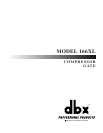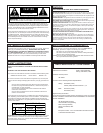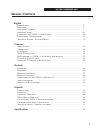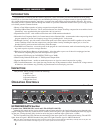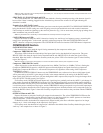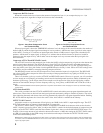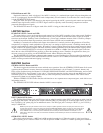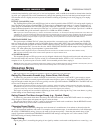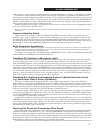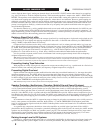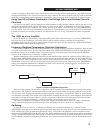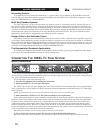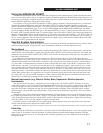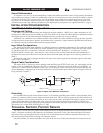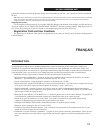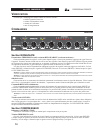
ating perfectly in-sync playing and overdubbing among individual instruments or “fattening” a dynamically weak track).
To create two distinct channels of bass guitar for your mix (by splitting the bass signal into two channels and syn-
chronizing one channel of bass guitar with the kick drum), start by feeding one channel of bass directly into the mix and
the other into the 166XL’s INPUT. Then key the gate with a signal from the kick drum (connected to the SIDECHAIN
INSERT - adjust controls as needed). The gated bass track will now open with each kick, adding punch and dynamics.
This can really tighten up the tracks and add life to the mix.
Another example of keyed gating is using the drum signal to key an oscillator which is set to an appropriate frequen-
cy to “tune” and “punch up” the drum sound.
Note: For all keyed gating applications, be aware to adjust the compressor accordingly or bypass it by setting the Compressor RATIO fully counter-
clockwise to 1:1
Frequency-Sensitive Gating
Frequency-sensitive gating lets you use the SIDECHAIN INSERT to tune the response of the gating action. For
example, if you’re gating a kick drum in a track with lots of leakage, you can tune in to the frequency of the kick with
an outboard EQ and the gate will respond only to that drum. Feed the kick drum signal both directly into the gate and
also through an equalizer which is connected to the SIDECHAIN INSERT. With the equalizer adjusted so that only the
desired signal is strong at the SIDECHAIN INSERT, the gate becomes even more selective in opening.
Basic Compressor Applications
Note: Control settings for each application are suggested as a starting point. Adjust them for your requirements. In general, the “smoothest” compres-
sion is achieved with the OVEREASY and AUTO buttons In, while the most “aggressive” compression is achieved with a Hard Knee fast setting (i.e.,
OVEREASY button Out with fast ATTACK and RELEASE times).
To compress a mix, begin with a low RATIO setting, THRESHOLD set for a few dB of Gain Reduction, and SLOW
Attack and Release, OVEREASY and CONTOUR buttons In.
Smoothing Out Variations in Microphone Levels
Variations in signal level can occur when the distance between a vocalist and a mic changes, or when the dynamics
of a voice changes relative to a vocalist’s range. To smooth out these variations, start with the 166XL in OverEasy
mode (OVEREASY button In) with a medium attack time and a fairly slow release time and adjusted for a low to medi-
um compression RATIO (e.g., 4:1). Many people prefer the use of AUTO mode for vocals rather than setting the attack
and release controls manually. Adjust the THRESHOLD control so that the GAIN REDUCTION meters show 6dB to
10dB of gain reduction, then increase the RATIO if necessary. Due to the gentle OverEasy characteristic of your 166XL
you will find that even fairly high ratios are handled transparently. If the lower energy of the vocals is compressed too
much (e.g., if the voice sounds too thin or its lower register presence is lost), press the CONTOUR button In to allow
more of the original low energy to pass through the 166XL unaffected.
Smoothing Out Variations (and Increasing Sustain) in Musical Instrument Levels
(e.g., Bass Guitar, Electric Guitar, Synthesizer)
To achieve a smoother electric (or electronic) bass sound, compress the instrument’s output with a RATIO of
approximately 4:1, then adjust the THRESHOLD control for 10dB to 12dB of gain reduction. Compression lessens the
loudness variations among the strings and increases the bass’ inherent sustain. Other instruments, such as horns, vary in
loudness depending on the note being played, and benefit similarly. Note that if the compressed bass sounds smooth, but
too thin for your needs, try pressing In the CONTOUR button to thicken the sound.
To control untimely volume shifts in “hot” guitar or synth parts and to keep them from overloading your tape deck or
mixer during recording and live performances, start with a slow Hard Knee compression, the RATIO at approximately
5:1 and the THRESHOLD set to the average maximum level of the track - this will ensure that only the offending “hot”
part is compressed. Use CONTOUR, if necessary.
To add sustain to guitar or synthesizer string sounds, begin with a higher RATIO (from 10:1 to !:1), then adjust the
THRESHOLD control to taste. For example, to alter the envelope of a synthesizer sound that has a bite on its attack, but
ends with a long release time, begin by playing slow, but steady, synth stabs or chords, while compressing the sound
heavily (with a higher RATIO). Heavy compression of guitars and synths, as they are being recorded to digital formats,
can often help revive their sense of “analog life.”
Fattening Kick Drums and Compressing Other Drums
Weak, flabby kick drums often have too much boom, and not enough slap. To tighten them up, start with the 166XL
adjusted for a medium to high RATIO (e.g., 6:1), adjust the THRESHOLD control so that the GAIN REDUCTION
meters show 15dB of gain reduction, then increase the RATIO if necessary. In OverEasy mode, the 166XL takes slight-
ly longer to react than in Hard Knee mode, and will therefore emphasize the slap at the beginning of the note and reduce
the boominess of its body. The 166XL also works well for tightening snare drums and tom toms and can be used with
drum machines to effectively alter the character of any electronic drum sound.
Cymbals and tom-toms can be effectively compressed (using the 166XL’s Sidechain) to help prevent analog tape sat-
dbx 166XL COMPRESSOR / GATE
7



